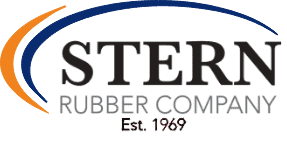Natural rubber used at Stern Rubber Company is made from a natural source as it is tree sap. Many consumers think that all rubber is associated with natural rubber, but natural rubber is only one type of rubber which includes different synthetic rubbers like EPDM, Silicone, Polychloroprene, Flourocarbon, Butyl, SBR, and Nitrile.
Natural rubber, which is also referred to as India rubber or caoutchouc, in scientific terms means that it is polymers of the organic compound isoprene, and is classified as an elastomer. Rubber is harvested from rubber trees, which are a family of trees that belong to the family Euphorbiace; Hevea brasilienisis or Sharinga trees are the most common. Natural rubber is extracted by method called tapping, by making incisions into the bark and collecting the fluid into vessels attached to the rubber trees. The liquid is a sticky, milky sap called latex, and requires a couple of steps before it will be sold as natural rubber.
Once the latex is collected from the plantation, is rushed to the processing plant, which prevents the latex from coagulating naturally and rendering the latex useless. At the processing plant near the plantation, the latex is heated and mixed with acid ammonia which forms rubber like curds; sulfur can be added to create a harder and more stable mixture. Much like making cheese, the rubber curds float to the surface of the liquid and is skimmed off the top and run through heavy rollers to remove excess water. The sheets of natural rubber that are formed are cut and stacked ready for shipment to rubber molders like Stern Rubber Company.
In the early 1830’s, natural rubber was used extensively, as “rubber fever” caught on, as everybody wanted things made of the “new” waterproof gum from Brazil, and factories sprung up to meet the demand. Unfortunately, this faded away as fast as it caught on, as the public become fed up with the messy stuff which froze bone-hard in winter and would become sticky and fall apart in the heat of the summer.
Charles Goodyear is credited with the invention of the process of vulcanization of natural rubber (and the process that is used today at every rubber molding company) that ended up solving the issues that plagued the early commercial uses of gum rubber, and it gained widespread use soon afterwards.
Located in the jungles of the Amazon rainforest in Brazil, the jungles of Asia, Malaysia, Thailand and Indonesia, the rubber producing plantations create the majority of natural rubber for the world. During World War 2, with Japan occupying the majority of the jungles in south East Asia, the United States had to find an alternative source for rubber, so research was funded that created synthetic rubber which was used to win the war.
Natural rubber is a very useful rubber and is used extensively at Stern Rubber Company. Besides from being extremely waterproof; it also has high resilience and stretch, and is often used in pneumatic applications such as tires. Natural rubber is often mixed with synthetic rubber to optimize the properties of both materials. While Stern Rubber does not produce them, the application for natural rubber that most people are familiar with, is rubber bands. Some of the parts that are produced at Stern Rubber include pneumatic plumbing test plugs, gaskets, and suction cups.
